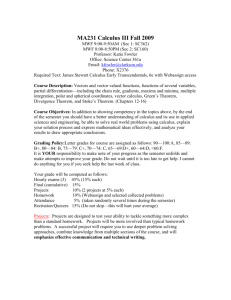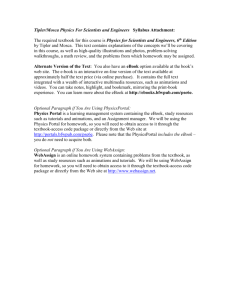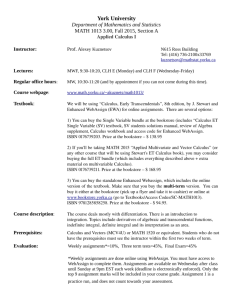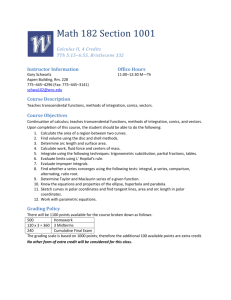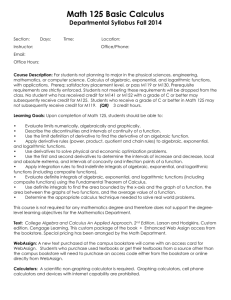Calculus at Holy Cross Fall 2014 You are receiving this message
advertisement
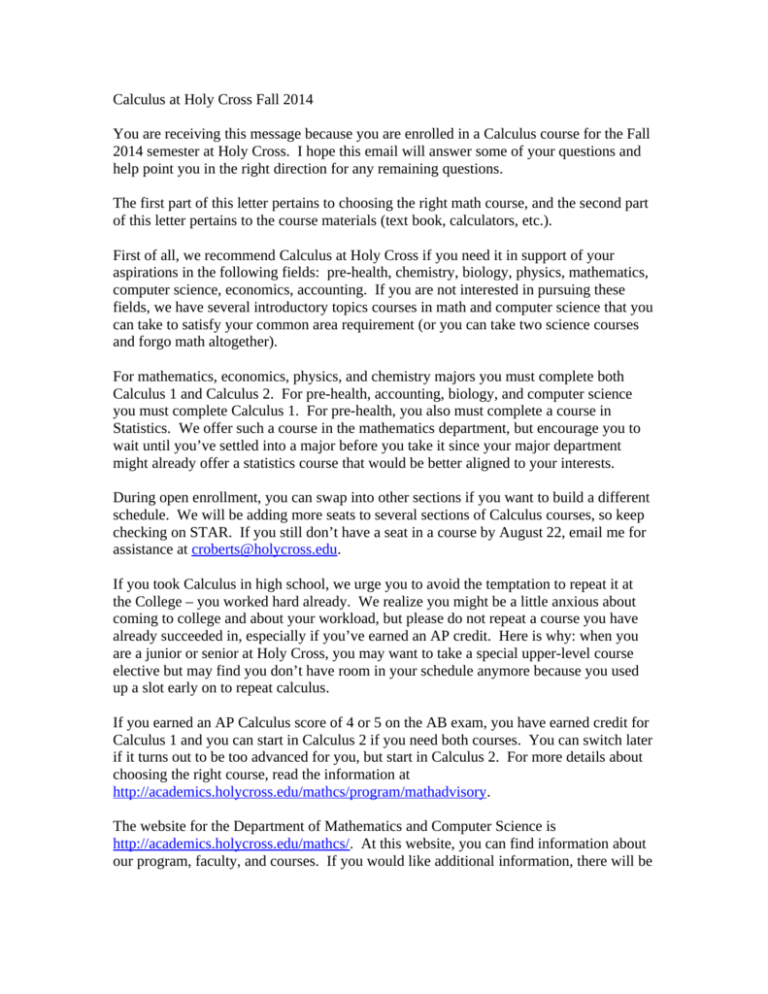
Calculus at Holy Cross Fall 2014 You are receiving this message because you are enrolled in a Calculus course for the Fall 2014 semester at Holy Cross. I hope this email will answer some of your questions and help point you in the right direction for any remaining questions. The first part of this letter pertains to choosing the right math course, and the second part of this letter pertains to the course materials (text book, calculators, etc.). First of all, we recommend Calculus at Holy Cross if you need it in support of your aspirations in the following fields: pre-health, chemistry, biology, physics, mathematics, computer science, economics, accounting. If you are not interested in pursuing these fields, we have several introductory topics courses in math and computer science that you can take to satisfy your common area requirement (or you can take two science courses and forgo math altogether). For mathematics, economics, physics, and chemistry majors you must complete both Calculus 1 and Calculus 2. For pre-health, accounting, biology, and computer science you must complete Calculus 1. For pre-health, you also must complete a course in Statistics. We offer such a course in the mathematics department, but encourage you to wait until you’ve settled into a major before you take it since your major department might already offer a statistics course that would be better aligned to your interests. During open enrollment, you can swap into other sections if you want to build a different schedule. We will be adding more seats to several sections of Calculus courses, so keep checking on STAR. If you still don’t have a seat in a course by August 22, email me for assistance at croberts@holycross.edu. If you took Calculus in high school, we urge you to avoid the temptation to repeat it at the College – you worked hard already. We realize you might be a little anxious about coming to college and about your workload, but please do not repeat a course you have already succeeded in, especially if you’ve earned an AP credit. Here is why: when you are a junior or senior at Holy Cross, you may want to take a special upper-level course elective but may find you don’t have room in your schedule anymore because you used up a slot early on to repeat calculus. If you earned an AP Calculus score of 4 or 5 on the AB exam, you have earned credit for Calculus 1 and you can start in Calculus 2 if you need both courses. You can switch later if it turns out to be too advanced for you, but start in Calculus 2. For more details about choosing the right course, read the information at http://academics.holycross.edu/mathcs/program/mathadvisory. The website for the Department of Mathematics and Computer Science is http://academics.holycross.edu/mathcs/. At this website, you can find information about our program, faculty, and courses. If you would like additional information, there will be an informational meeting about the majors in mathematics and computer science in Swords 307/312 on Monday, September 1 at 8 AM. The College provides different Calculus course options to our students. You have selected the course that you and your advisors believe is the best fit for your background and your academic goals. Please realize that you will have the opportunity to change to another course during the first few days of classes this fall, in the event that you discover that you’d be better off in a different course. Nonetheless, a little time spent now might help ensure that you get the proper placement, particularly now that you have received your AP Exam scores. The best place to start is to read the information provided in this link: http://academics.holycross.edu/mathcs/program. The biggest point of confusion seems to be between Math 133 and Math 135. Most students should take Math 135 Calculus 1, even if you haven’t had any calculus before. Math 133 is a special course for students who need more support as they transition to college-level mathematics and you should consult with me if you think you want that course. Entry into Math 133 is by permission-only. After reading the information in the link above, you may still have some questions. If so, there are many places you can turn. You may consult your Class Dean or faculty advisor. If you are an incoming first-year student, you may not know who has been assigned to be your faculty advisor yet. This information will be sent to you soon and you will be meeting with this professor when you first arrive on campus this fall. You could consult with the instructor who is assigned to teach the section in which you’ve already registered. Email is usually the most efficient way to reach the professors in our department over the summer and you can find their email addresses at the website link above. You can also contact me, Professor Catherine A. Roberts. I am the chair of the Department and will be managing the enrollments in math courses this year. You can reach me at croberts@holycross.edu. My office is Haberlin Hall, Room 310 and you can always stop by to sign up for an appointment on the sign-up sheet on my door, or you can stop by during my office hours, which are also posted on my door. I am available most of the time between 8:30 AM – 4:00 PM. The extent of calculator use in the classroom depends on the philosophy of your instructor. There is no need to purchase a fancy calculator for calculus. During exams, most professors permit scientific calculators (such as TI-30XA) but not graphing calculators (such as the TI-83). If you have a scientific calculator, professors will probably allow you to use it during exams. These calculators are not very expensive, and are available for purchase at the Holy Cross Bookstore. We may have some loaner calculators available. Since the order-of-operations can vary from one calculator to the next, you may wish to purchase your own so that you will be comfortable. This message contains the official information about the textbook that has been adopted for use for the 2014-2015 academic year. The same textbook will be used by all sections of Math 133, Math 135, and Math 136 this fall, as well as sections of Math 134, Math 135, and Math 136 in the spring. If you are planning to take a two-semester calculus sequence (Math 133/134 or Math 135/136), the same one textbook will be used for both semesters. The textbook is James Stewart, Single Variable CALCULUS Concepts & Contexts 4E (2010, Thompson Brooks/Cole Publishers). In addition to the textbook, courses will be using an online homework system called WebAssign. Some students have already been contacting me for information about the textbook for Calculus. Please read this entire letter to understand how to get your book. The textbooks for all of your courses will be available for sale at the College Bookstore. They can be ordered online and shipped to your home, or you can purchase them in person once you are on campus. Some students choose to purchase their books ahead of time through a different venue, although you’ll see that your best price will be with the campus bookstore. Some of you might have book vouchers associated with your financial aid package; these vouchers are only valid at the campus bookstore. It is important that you have your textbook right at the start of classes. Save your receipt in case you decide to switch to another course so you can return your book. The book is required. You can use an online or paper copy of the book. Please note that this is the newest version (the 4th edition). An earlier edition will not work for this course. Moreover, Stewart has authored multiple texts and you need to make sure you get the Single Variable version (as opposed to the “complete” version) of the Concepts & Context book. If you accidentally purchase the “complete” text, which includes both the single and the multi-variable chapters, you’ll be buying more than you will use. While we do teach a multi-variable calculus course (Math 241), the HC course you might eventually take will not necessarily use this particular textbook. WebAssign is required. This tool is an online homework system. It will be used to varying degrees, depending upon your particular instructor. You will be taught how to use this online system during the first week of class. Access is controlled by a code that will come bundled to your textbook if you buy it in the HC Bookstore. Your WebAssign access code will not be needed until the second week of the semester, because all students are given a 14-day grace period with free access to the website. If you end up switching to a different course, you can return your book and your unopened access code envelope back to the campus bookstore, if you purchased it there. If you buy your book elsewhere (such as used on Amazon or from a friend), you can pay for the WebAssign access online with a credit card after your 14-day grace period is over. Options for Purchasing your Calculus Text and WebAssign Access Code (preferred) #1 Total Cost: $165 Purchase a custom soft-cover book at the Holy Cross campus bookstore that is bundled with the WebAssign access code. You can order it online or in person. The book will be available at the bookstore and online at Bookstore.Holycross.edu. The ISBN for this custom text with WebAssign access is ISBN 1111494401. You will have free access to WebAssign for 14 days, so do not open or use your access code until you are certain that you will need it. This is a special deal that the college has made with the publisher to save you money – the deal is only available at the campus bookstore. #2 Total Cost: $242.99 from http://www.cengagebrain.com Purchase the same thing as #1 online. This will be a hardcover book plus the access code for WebAssign. The ISBN for the two items combined is 1111034680 – enter this ISBN into the box at the top of the website given below. #3 Total Cost: varies from http://www.cengagebrain.com/shop/isbn/9780495559726 There are too many options here for me to count. If you start at this link, you’ll see options for the Hardcover book ($221.49), book rental ($43.99 for the year), ebook ($54.99), eChapter. You can click on the Bundle & Save tab and buy the book with a Student Solutions Manual (which can be nice, although it will be available on reserve in the library for free consultation) and a Student Study Guide (again, can be nice, but will also be available on reserve in the library for free consultation). #4 Total Cost between $65 - $180. Find a used book somewhere, or go to a site such as Amazon.com and order the book, new or used. The ISBN is: 0-495-55972-5. When you start the course this fall, you will use the 14-day free grace period on WebAssign and then you’ll be prompted to enter a credit card to buy the online access. This will cost you $65. (If you have a free or cheap second-hand book then this is definitely your cheapest option.) #5 Total Cost: $95 Purchase the online code for WebAssign along with an online version of the book (ebook) once you settle in this fall. Pay nothing now. After you start the class, every time you login to WebAssign, you’ll be prompted to pay for full access. From within the WebAssign system, you’ll get the best bargain. The best choice here would be to choose the webassign access with a LOE (life of edition) access to the ebook, but you have other choices, as well. The ebook is not downloadable, so you will always need an internet connection to access the book. You can purchase this now by going to the link in #2 and using ISBN 1-285-18421-1, but my suggestion is that you wait and do it from campus. Here is what you will actually see when you go to pay on WebAssign (prices could be slightly higher). The ebook upgrade means that you will have access to the ebook on webassign. If you just buy homework then you will not have access to the ebook and be able to see the homework only. Life of the edition means that the code is good as long as the student enrolls in any courses that are using the same text and edition. Single term is that it is only good for 1 semester. So, if you already own a text book and are willing to skip having access to the eBook, then just pay $47 for one semester HW or $65 for lifetime of edition access. You should do the lifetime access if you are planning to take Calculus 2 after Calculus 1, but if you are in Calculus 2, just one semester will suffice. Some of our professors use Stewart in Multivariable Calculus (Math 241), but others do not, so there's no guarantee if you buy it that you will get to use it in Multivariable. To get the $95 price, you have to exit WebAssign and to to www.cengagebrain.com to purchase your code. The code sold through cengagebrain is life of the edition with ebook & homework. The price online on this site is $95.00. You will receive instant access and not have to wait for a passcode to be mailed to you. To do this option, go to www.cengagebrain.com and enter 1-285-18421-1 into the Search box. ============================================ Some faculty have expressed some skepticism about the ebook as a useful learning tool. On the other hand, we recognize that more and more students are quite comfortable with online books. You need to make your own call here. Please note that you won’t have this ebook forever, as the online access is limited to the “life of edition,” which means that once the publisher comes out with the 5th edition of this book, your access is over. There are various options beyond the LOE access described above – for example, you can purchase the ebook chapter-by-chapter. We advise against purchasing the book in chapter-sized bits, because you’ll miss out on important supplementary material such as the appendices. While there is a distinct price advantage to going with the ebook + WebAssign, if you think you will be taking additional math and science courses at Holy Cross, you may find having a Calculus textbook as a reference tool is a must for some of your upper-level courses. Of course, it doesn’t need to be this particular version of the textbook; you can probably pick up an older version of this book (or another one altogether) at a used bookstore rather cheaply. =========================================== Finally, there are two additional optional study tools that you might be interested in. These are not required by the faculty at Holy Cross, although some students find them useful. Both of these books are available on reserve in the Science Library for you. They are not available for purchase in our campus bookstore. 1. Student Solutions Manual for Stewart’s Single Variable Calculus: Concepts and Contexts, 4th. This contains the solutions to the odd-numbered problems, with most of the work shown. The ISBN is 0-495-56061-8. On Amazon, the cost was $84.99 new, lower prices to rent or used. It was on cengagebrain.com for $129.49. There is a copy on reserve in the Science Library for your use. 2. Study Guide for Stewart’s Single Variable Calculus: Concepts and Contexts, 4th. This book gives summaries of the key points in each section of the book and points out common stumbling blocks for students. ISBN 0-495-56064-2. I found this at amazon.com for $27.99 (new) and lower for used copies or rented copies. On cengagebrain.com, the cost was $1115.49 for a hard copy and $22.99 for an eBook. There is a copy on reserve in the Science Library for your use. Sincerely, Prof. Catherine A. Roberts, Chair Department of Mathematics and Computer Science August 2014 croberts@holycross.edu Haberlin Hall, Room 310

